CyberPower: 4.0 GHz QX9770 and SLI GTX 280s
by Matt Campbell on August 22, 2008 4:00 AM EST- Posted in
- Systems
Setup and Startup
Many systems that are shipped, and particularly the large ones like this, get knocked around and often need a little re-seating of everything prior to bootup. Upon first power up, we were greeted with a "Media test failure" from NVIDIA Boot Agent. Pushing a loose S-ATA connection back in fixed this error, and we tightened the SLI bridge while we were at it, which was also loose.
First, let's take a look in the BIOS. The review system came factory overclocked to 4.0 GHz.


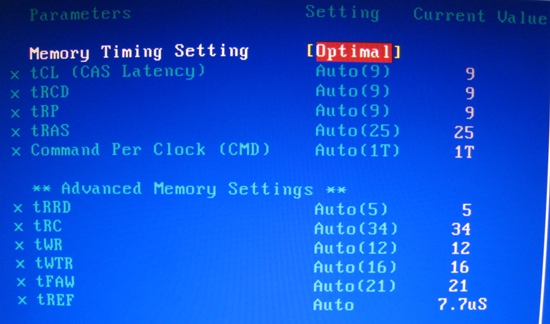

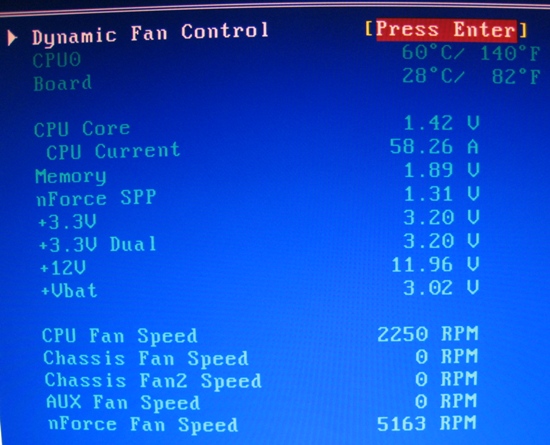
Obviously the CPU and memory voltages have been increased, and the multiplier increased, but this is a pretty straightforward overclock with little tweaking necessary. The Memory Settings are "Optimal" but could have been played with further. This is still a good result, it's just not the same level of attention that a boutique would offer (and questionable value at an extra charge of $100 over a stock QX9770, though the manufacturer warranty remains in effect). Note the temperature sitting at 60C at idle - we'll address this further later.
So what are we greeted with at first boot?
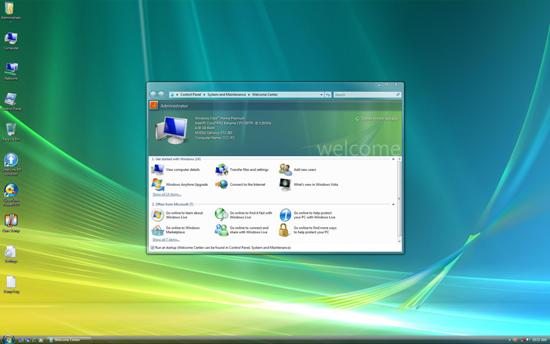 |

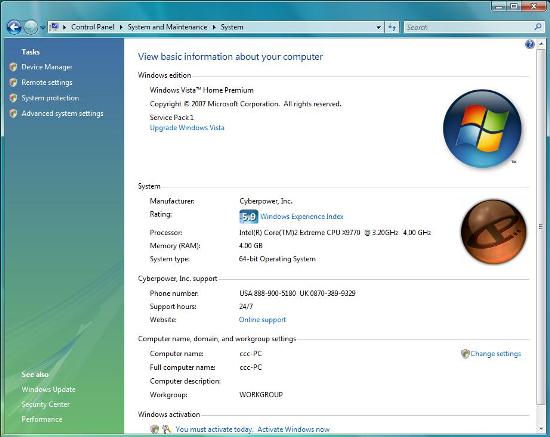

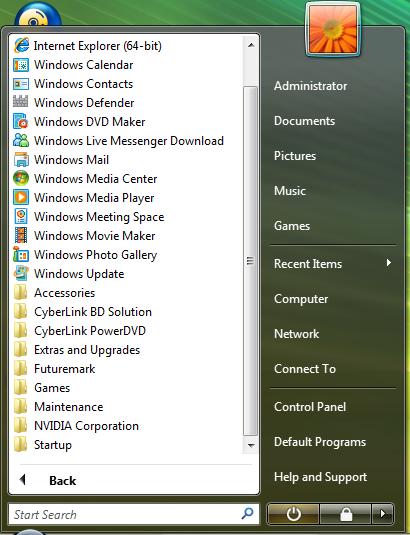
Overall, quite a nice result. The desktop is relatively clear at startup (particularly if the CoreTemp configuration and log files are ignored). The number of processes is a little higher that the absolute minimum, but 44 for a prebuilt PC is an excellent result. Also, we see that CyberPower lists their Support contact information in Vista, which is always a nice touch. However, automatic updates was delivered turned on, which is annoying on this type of machine - at the most it should be set to download automatically, but prompt for installation. We also have to note the lack of an anti-virus system, even if it's an optional install on startup. (Ed: Many of us at AnandTech avoid AV and Internet Security software these days, but then we also build our own PCs.) Other than these minor nits, the startup experience is a pleasant one.
The video card drivers were up-to-date at the time of shipping (177.39), and were used throughout this review except where otherwise noted. Vista also shipped with Service Pack 1 installed.
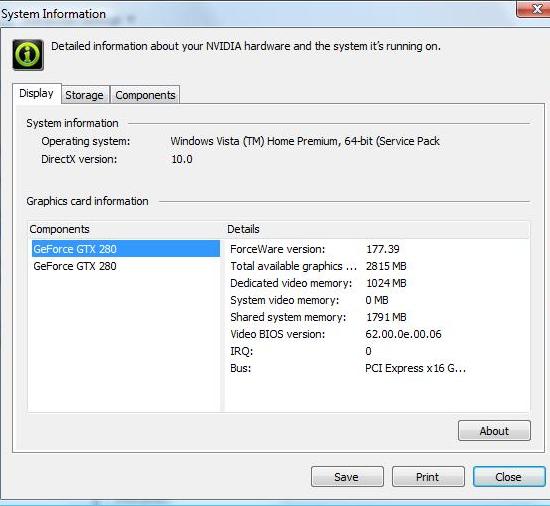
Almost brings tears of joy, doesn't it?
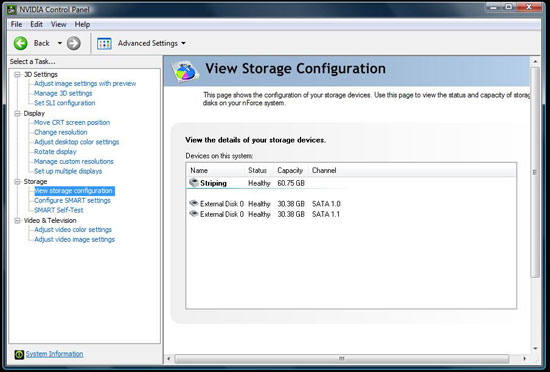 |
On to performance!










30 Comments
View All Comments
JarredWalton - Saturday, August 23, 2008 - link
Eh? My gaming PC right now is X38 with 3870 CrossFire. That list I just posted was a recommendation for a current setup that would use 4870X2 (or even Quad-CrossFire if you're daring). I think it's a reasonable recommendation for a high-end system right now. If you prefer NVIDIA SLI, go with a couple GTX 260 cards and a 790i motherboard.strikeback03 - Monday, August 25, 2008 - link
Page 8, the 3DMark Vantage Section"The CyberPower machine well and truly demolishes a respectable gaming machine (Q6600 @ 3.3GHz, SLI 3870s). " Wrong multi-GPU acronym used.
And speaking of those charts, is there a way to present the names so that the actual data bars are not only 1/4 or less of the total chart width?
JarredWalton - Saturday, August 23, 2008 - link
I'm still using the Q6600 at 3.30GHz... but it's a bit long in the tooth compared to 4850/4870. I'd like to upgrade GPUs, but divorce attorneys are expensive. :(7Enigma - Friday, August 22, 2008 - link
Count me in as well on being baffled by the choice of PSU and amount of ram. You could EASILY decrease the cost of this computer and increase potential performance by doubling the system ram and halving the power supply.And I have never understood case designs that have the PSU's on the bottom. IMO they should be installed near the top with either a back exhaust or better yet a blow-hole style outlet (you'd need the PSU manufacturer to put the outlet on the top though). Just seems pretty silly to have these monsters heating up the whole case when they should be helping to exhaust the hot air the rest of the system is producing (and the PSU's themselves). I'm wondering if this is a potential cause of the extremely high core temps...
Which brings me to the fact that I wouldn't touch this system even if I had the money to blow on it. Longevity concerns are real when operating at those levels, especially with the likelihood that buyers may not have the system in an area as cool as your testing room.
Can you guys comment on the water cooling system? Is the resevoir/design too small or poorly placed causing the high idle temperatures? Did you remove any of the mounts to see if there was something affecting heat transfer either at the cores or at the radiator?
But all in all, nice review!
MamiyaOtaru - Sunday, August 24, 2008 - link
I like having the PSU at the bottom. Using it to exhaust CPU heat fatigues it. I prefer having the PSU down at the floor, bringing in cool air, then dumping its exhaust out the back. In my box this lets it run very quietly. I've still got two 120mm fans exhausting heat from behind the CPU which isn't hot at all.This way I don't have CPU heat in the PSU, and I don't have a lot of PSU heat in the CPU (most goes out the back). But then I don't have two 1000W monsters.
Matt Campbell - Friday, August 22, 2008 - link
Here's a link to the cooler used in this system: http://www.northq.com/products/coolers/nq3580.html">http://www.northq.com/products/coolers/nq3580.htmlIt's small and compact, and the radiator mounts in front of a 120mm rear exhaust fan. There's no doubt in my mind that the amount of hardware in the case contributes to high idle temperatures, and that a large external water cooling system would decrease temperatures considerably (but wouldn't be such a slick in-case solution). NorthQ also offers a dual-radiator design (the 3590), but it wouldn't fit in the NZXT case, which is the only option for the Xtreme XI.
7Enigma - Friday, August 22, 2008 - link
Do you think something like the Thermalright Ultra 120 extreme (or whatever the current best air cooled solution) would actually offer better cooling that the nq3580?I know water can carry much more heat away than air, but I wonder if in this case that is actually hurting the temps as it's also being circulated back onto the cores at an elevated temperature.
Even better for this behemoth of a system would probably be to take a page from Dell or other large manufacturer that uses the shroud to pull "protected" air from outside the case, directly over the core, and out again. This would prevent the air from being warmed considerably by the other components.
7Enigma - Friday, August 22, 2008 - link
Forgot to add it looks like the PSU fan is partially blocked by the Cyberpower metal "thing". What the heck is the purpose of that piece, and why is it obstructing the fan?7Enigma - Friday, August 22, 2008 - link
Upon further looking at the pictures (for some reason the last picture in the internals is not coming up) it appears that the water cooling is only for the CPU correct? And that the small 90-120mm radiator where a normal external case fan would be is the sole way of dissapating heat? So there really is no water "block" of liquid and only the small amount of liquid in the lines is absorbing the heat?In a system with 2 280's, 2 1k PSU's, 4 HD's, and 2 optical drives, I could easily see how the cooling system would not be up to the task (due to all the heat soak prior to getting to the CPU cores). I would think an external block with radiator would be immensely more efficient, though you would of course lose the coolness factor of having it all in a single case....
JarredWalton - Friday, August 22, 2008 - link
The cooling is sufficient I think, for everywhere except perhaps the CPU. I'd wager that an Ultra-120 eXtreme would beat it, but that's just a guess. As for the rest of the comments, while two PSUs is certainly overkill for this particular configuration, doubling the RAM will hardly have an impact on most things. I've got a 4GB system and a 2GB system (64-bit and 32-bit), with similar parts elsewhere. Unless I really open a LOT of applications (and 32-bit ones at that, since there are very few 64-bit apps), I couldn't tell them apart.